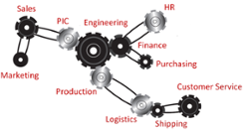"We cannot predict the future, but we can invent it." - Dandridge M. Cole
 Your organization is like a machine. Each component is expected to work in harmony with the others as a system. Systems thinking focuses on how individual changes within that machine affect the whole. It drives changes that eliminate obstacles in the way of achieving your goals, yet in an optimized way. In a nutshell, systems thinking recognizes that the organization, or machine, is only as good as the weakest component.
Your organization is like a machine. Each component is expected to work in harmony with the others as a system. Systems thinking focuses on how individual changes within that machine affect the whole. It drives changes that eliminate obstacles in the way of achieving your goals, yet in an optimized way. In a nutshell, systems thinking recognizes that the organization, or machine, is only as good as the weakest component.
Developing successful strategies involve answering four questions:
1) Where are we now?
2) Where do we want to be?
3) How do we get there?
4) What obstacles stand in our way?
The tactics involved in working your plan revolve around:
» Eliminating these obstacles
» Assigning responsibilities for those tactics
» Monitoring execution of tactics
» Measuring degree of success of tactics
Strategic Systems Planning is an extremely effective, but simple process for creating your unique roadmap to fulfilling your vision and achieving your goals. It provides a simple, standardized approach to strategic planning and, just as importantly, execution management.
Course Objectives
» Development of internal strategic and systems thinkers
» Provide the core methodology for development, execution and management of strategic plans
» Development of your organization’s roadmap to successfully achieve your goals and objectives
» The beginning of world class transformation
Prerequisite: Completion of the Lean Enterprise Certification Program (LECP)
or equivalent knowledge and experience
1. Fundamentals of the World Class Enterprise
|
2. Strategic Value Stream Management
|
3. The Standardized Approach to Strategic Planning
|
4. Managing in Real Time and Measuring Success
|
5. Transformation Planning: Strategy A3 (Part 1)
|
6. Transformation Planning: Strategy A3 (Part 2)
|
This course emphasizes practical application through classroom exercises and homework assignments focused on the development of your strategic plan, management and execution of the plan, and monitoring success. Ultimately, providing the experience and model for enterprise-wide transformation.